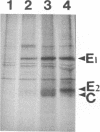Abstract
Rubella virus (RV) virions contain two envelope glycoproteins (E1 and E2) and a capsid protein (C). Noninfectious RV-like particles (VLPs) containing three structural proteins were expressed in a BHK cell line (BHK-24S) by using an inducible promoter. These VLPs were found to resemble RV virons in terms of their size, their morphology, and some biological activities. In immunoblotting studies, VLPs were found to bind similarly to native RV virions with 10 of a panel of 12 RV-specific murine monoclonal antibodies. Immunization of mice with VLPs induced specific antibody responses against RV structural proteins as well as virus-neutralizing and hemagglutination-inhibiting antibodies. After immunization of mice with VLPs, in vitro challenge of isolated lymphocytes with inactivated RV and individual RV structural proteins stimulated proliferation. Our data suggest the possibility of using VLPs as immunogens for serodiagnostic assays and RV vaccines.
Full text
PDF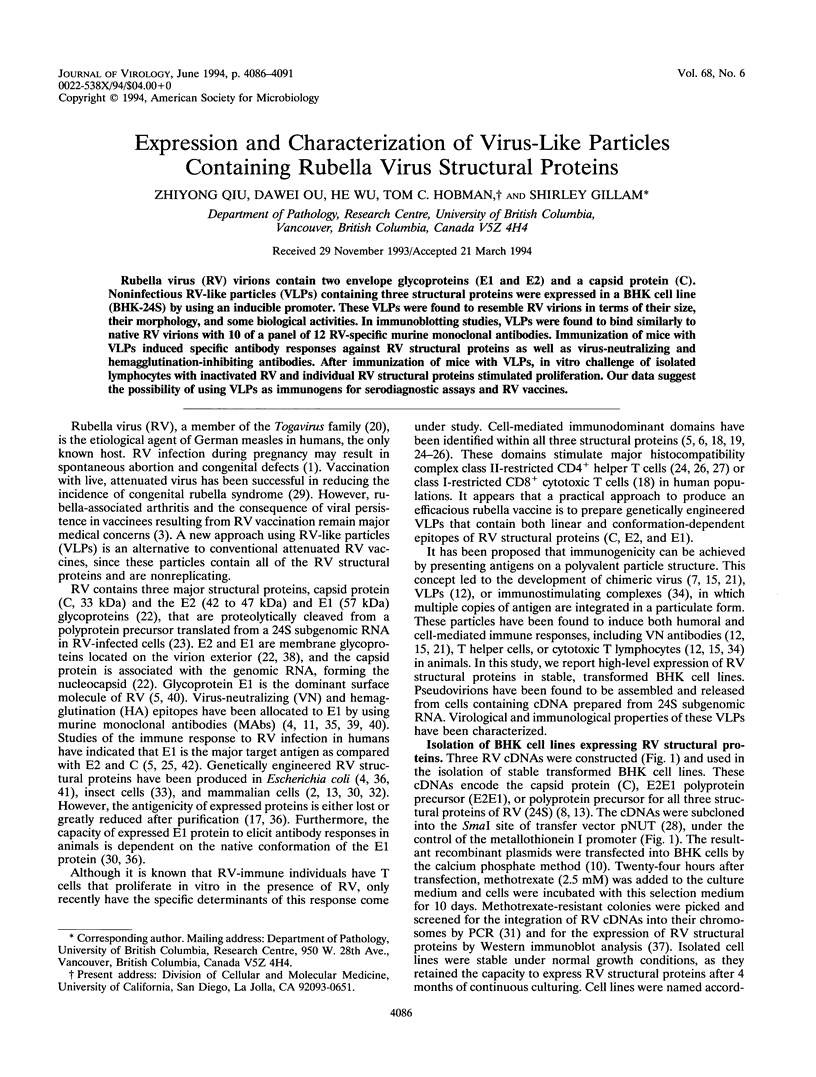
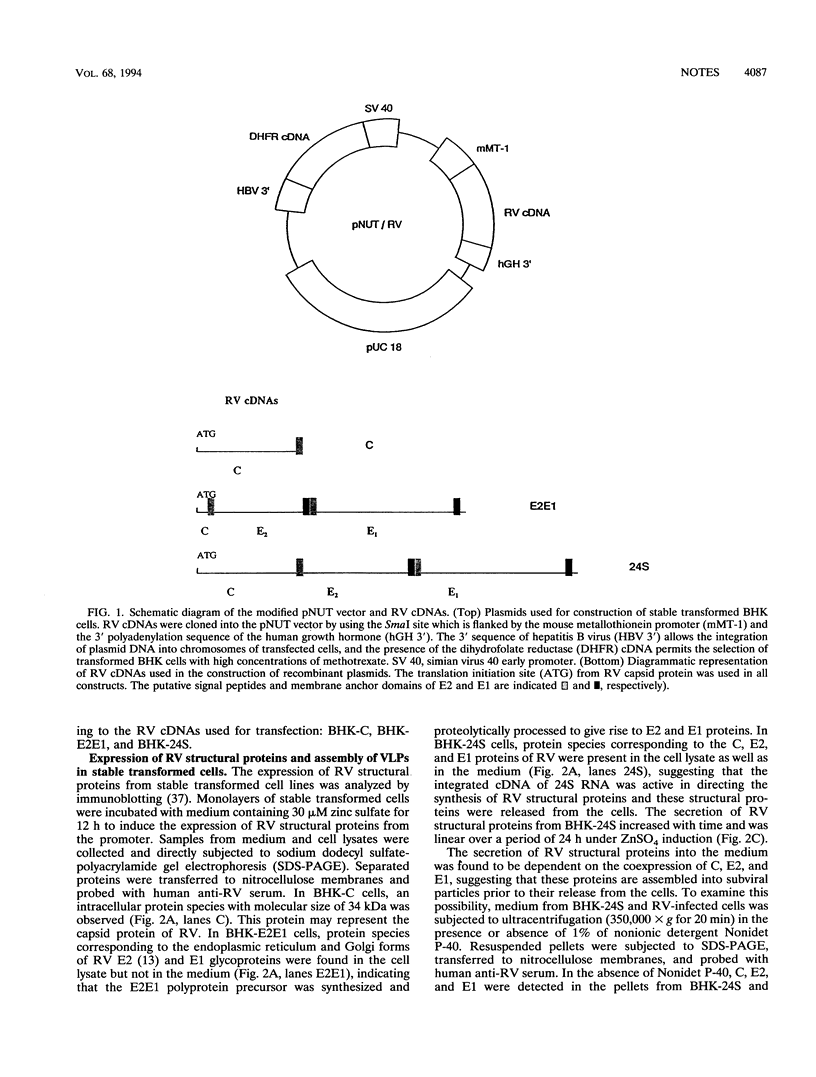
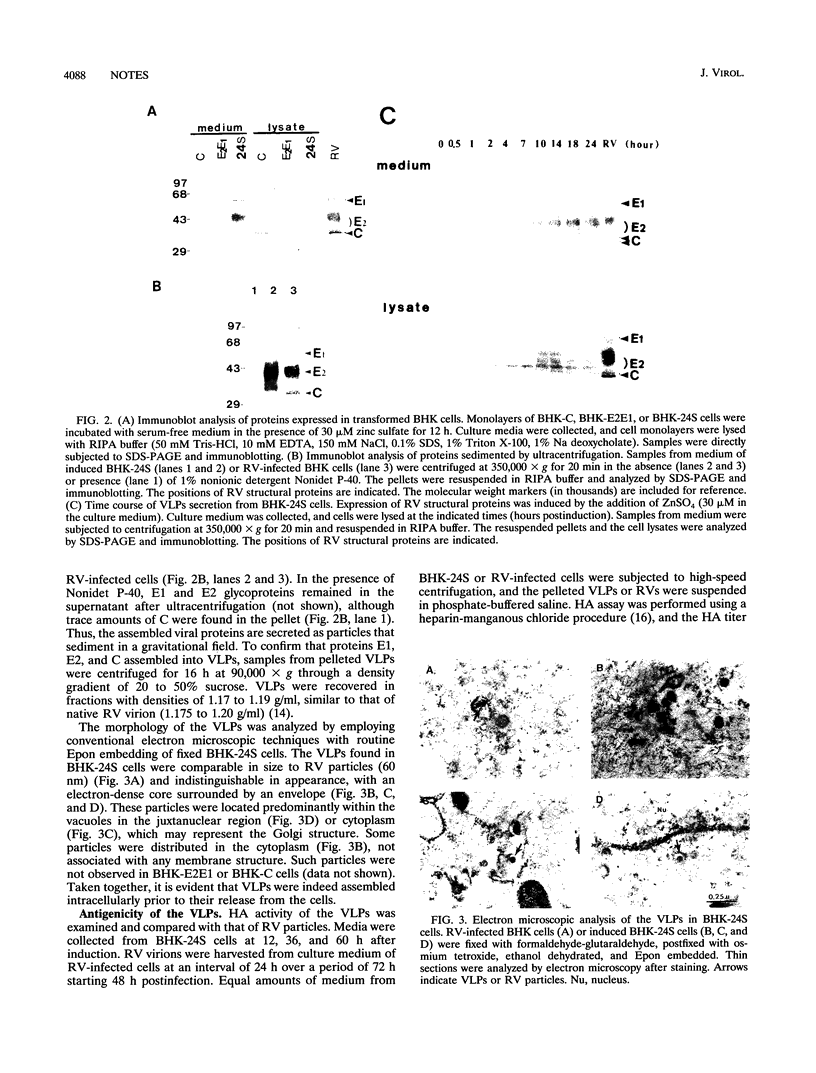
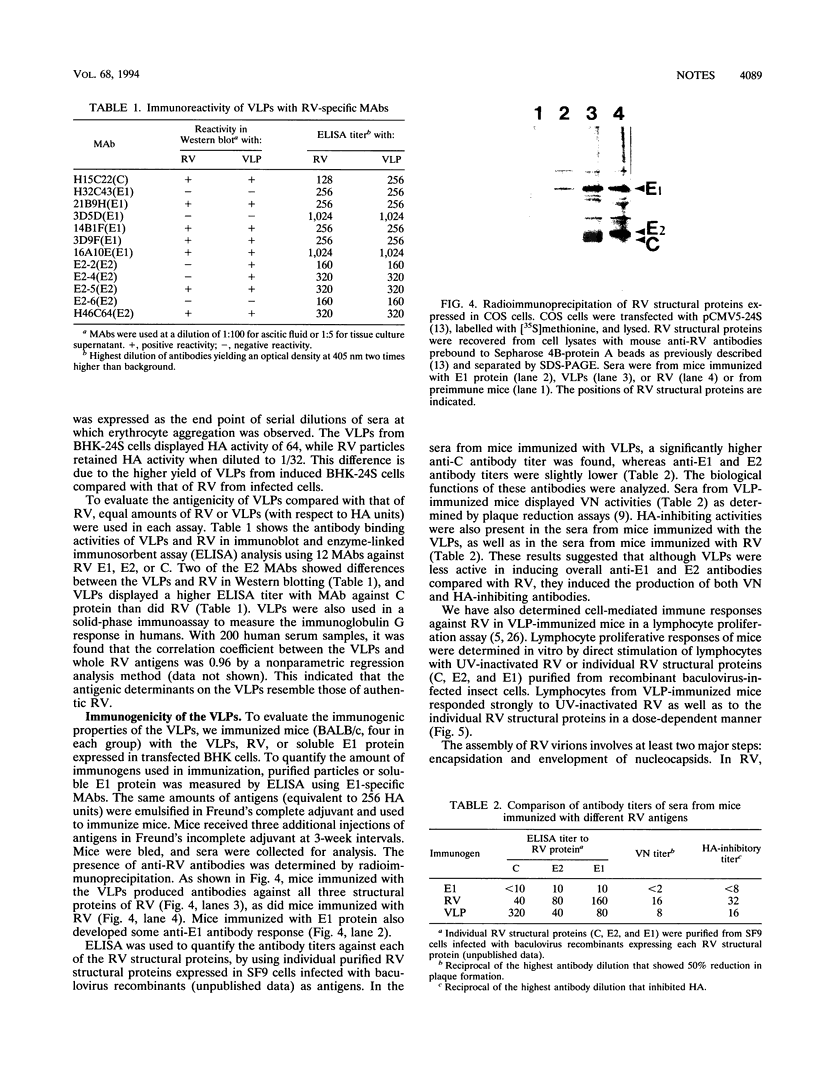
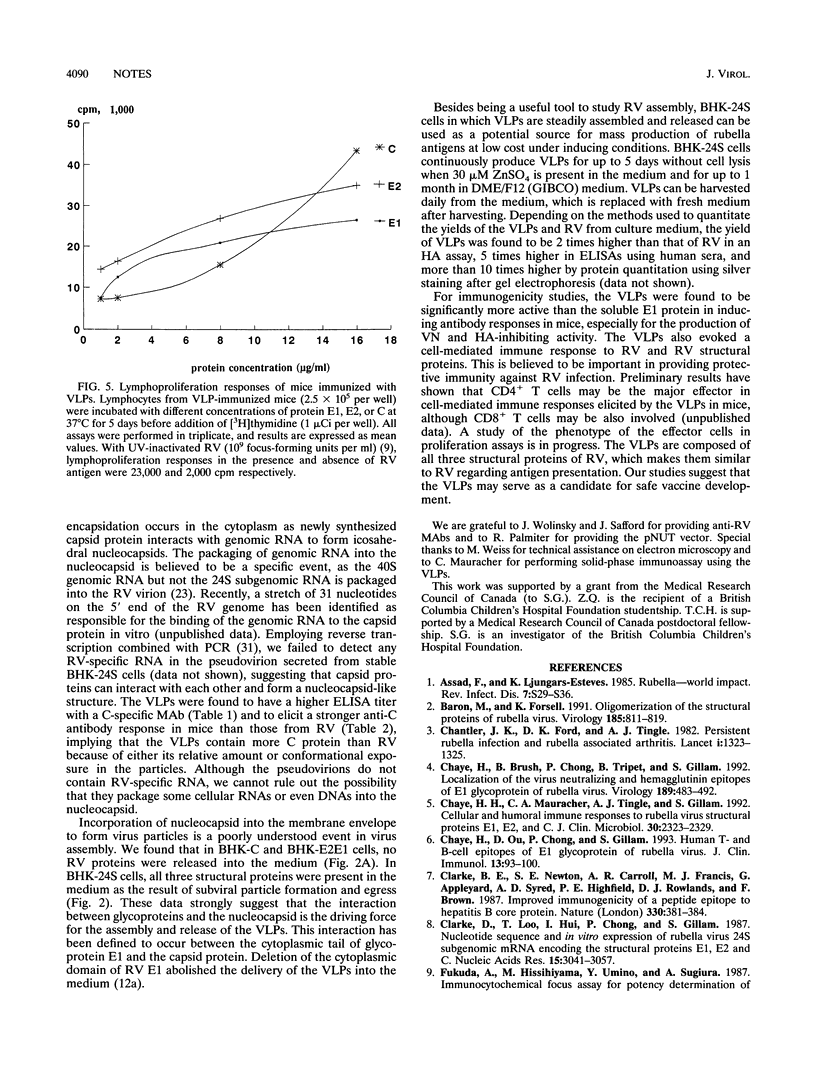
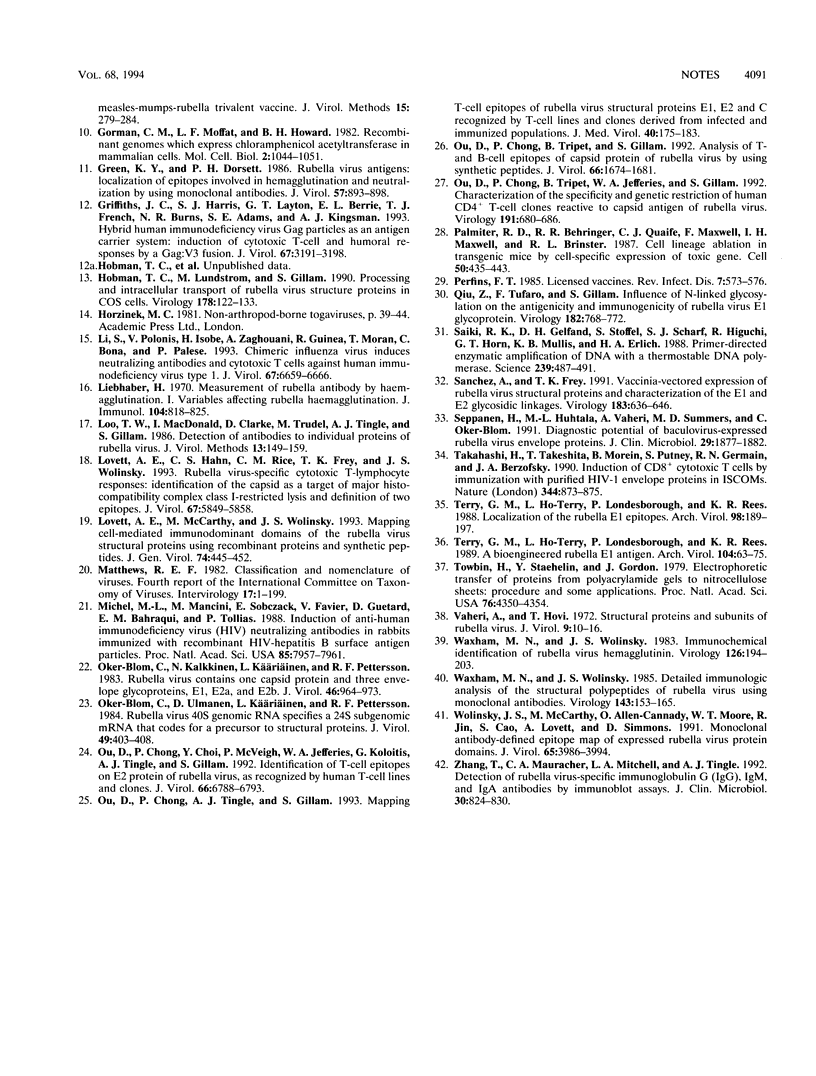
Images in this article
Selected References
These references are in PubMed. This may not be the complete list of references from this article.
- Assaad F., Ljungars-Esteves K. Rubella--world impact. Rev Infect Dis. 1985 Mar-Apr;7 (Suppl 1):S29–S36. doi: 10.1093/clinids/7.supplement_1.s29. [DOI] [PubMed] [Google Scholar]
- Baron M. D., Forsell K. Oligomerization of the structural proteins of rubella virus. Virology. 1991 Dec;185(2):811–819. doi: 10.1016/0042-6822(91)90552-m. [DOI] [PubMed] [Google Scholar]
- Chantler J. K., Ford D. K., Tingle A. J. Persistent rubella infection and rubella-associated arthritis. Lancet. 1982 Jun 12;1(8285):1323–1325. doi: 10.1016/s0140-6736(82)92398-4. [DOI] [PubMed] [Google Scholar]
- Chaye H. H., Mauracher C. A., Tingle A. J., Gillam S. Cellular and humoral immune responses to rubella virus structural proteins E1, E2, and C. J Clin Microbiol. 1992 Sep;30(9):2323–2329. doi: 10.1128/jcm.30.9.2323-2329.1992. [DOI] [PMC free article] [PubMed] [Google Scholar]
- Chaye H., Chong P., Tripet B., Brush B., Gillam S. Localization of the virus neutralizing and hemagglutinin epitopes of E1 glycoprotein of rubella virus. Virology. 1992 Aug;189(2):483–492. doi: 10.1016/0042-6822(92)90572-7. [DOI] [PMC free article] [PubMed] [Google Scholar]
- Chaye H., Ou D., Chong P., Gillam S. Human T- and B-cell epitopes of E1 glycoprotein of rubella virus. J Clin Immunol. 1993 Mar;13(2):93–100. doi: 10.1007/BF00919265. [DOI] [PubMed] [Google Scholar]
- Clarke B. E., Newton S. E., Carroll A. R., Francis M. J., Appleyard G., Syred A. D., Highfield P. E., Rowlands D. J., Brown F. Improved immunogenicity of a peptide epitope after fusion to hepatitis B core protein. 1987 Nov 26-Dec 2Nature. 330(6146):381–384. doi: 10.1038/330381a0. [DOI] [PubMed] [Google Scholar]
- Clarke D. M., Loo T. W., Hui I., Chong P., Gillam S. Nucleotide sequence and in vitro expression of rubella virus 24S subgenomic messenger RNA encoding the structural proteins E1, E2 and C. Nucleic Acids Res. 1987 Apr 10;15(7):3041–3057. doi: 10.1093/nar/15.7.3041. [DOI] [PMC free article] [PubMed] [Google Scholar]
- Classification and nomenclature of viruses. Fourth report of the International Committee on Taxonomy of Viruses. Intervirology. 1982;17(1-3):1–199. doi: 10.1159/000149278. [DOI] [PubMed] [Google Scholar]
- Fukuda A., Hishiyama M., Umino Y., Sugiura A. Immunocytochemical focus assay for potency determination of measles-mumps-rubella trivalent vaccine. J Virol Methods. 1987 Mar;15(4):279–284. doi: 10.1016/0166-0934(87)90150-9. [DOI] [PubMed] [Google Scholar]
- Gorman C. M., Moffat L. F., Howard B. H. Recombinant genomes which express chloramphenicol acetyltransferase in mammalian cells. Mol Cell Biol. 1982 Sep;2(9):1044–1051. doi: 10.1128/mcb.2.9.1044. [DOI] [PMC free article] [PubMed] [Google Scholar]
- Green K. Y., Dorsett P. H. Rubella virus antigens: localization of epitopes involved in hemagglutination and neutralization by using monoclonal antibodies. J Virol. 1986 Mar;57(3):893–898. doi: 10.1128/jvi.57.3.893-898.1986. [DOI] [PMC free article] [PubMed] [Google Scholar]
- Griffiths J. C., Harris S. J., Layton G. T., Berrie E. L., French T. J., Burns N. R., Adams S. E., Kingsman A. J. Hybrid human immunodeficiency virus Gag particles as an antigen carrier system: induction of cytotoxic T-cell and humoral responses by a Gag:V3 fusion. J Virol. 1993 Jun;67(6):3191–3198. doi: 10.1128/jvi.67.6.3191-3198.1993. [DOI] [PMC free article] [PubMed] [Google Scholar]
- Hobman T. C., Lundstrom M. L., Gillam S. Processing and intracellular transport of rubella virus structural proteins in COS cells. Virology. 1990 Sep;178(1):122–133. doi: 10.1016/0042-6822(90)90385-5. [DOI] [PMC free article] [PubMed] [Google Scholar]
- Li S., Polonis V., Isobe H., Zaghouani H., Guinea R., Moran T., Bona C., Palese P. Chimeric influenza virus induces neutralizing antibodies and cytotoxic T cells against human immunodeficiency virus type 1. J Virol. 1993 Nov;67(11):6659–6666. doi: 10.1128/jvi.67.11.6659-6666.1993. [DOI] [PMC free article] [PubMed] [Google Scholar]
- Liebhaber H. Measurement of rubella antibody by hemagglutination inhibition. I. Variables affecting rubella hemagglutination. J Immunol. 1970 Apr;104(4):818–825. [PubMed] [Google Scholar]
- Loo T. W., MacDonald I., Clarke D. M., Trudel M., Tingle A., Gilam S. Detection of antibodies to individual proteins of rubella virus. J Virol Methods. 1986 May;13(2):149–159. doi: 10.1016/0166-0934(86)90083-2. [DOI] [PubMed] [Google Scholar]
- Lovett A. E., Hahn C. S., Rice C. M., Frey T. K., Wolinsky J. S. Rubella virus-specific cytotoxic T-lymphocyte responses: identification of the capsid as a target of major histocompatibility complex class I-restricted lysis and definition of two epitopes. J Virol. 1993 Oct;67(10):5849–5858. doi: 10.1128/jvi.67.10.5849-5858.1993. [DOI] [PMC free article] [PubMed] [Google Scholar]
- Lovett A. E., McCarthy M., Wolinsky J. S. Mapping cell-mediated immunodominant domains of the rubella virus structural proteins using recombinant proteins and synthetic peptides. J Gen Virol. 1993 Mar;74(Pt 3):445–452. doi: 10.1099/0022-1317-74-3-445. [DOI] [PubMed] [Google Scholar]
- Michel M. L., Mancini M., Sobczak E., Favier V., Guetard D., Bahraoui E. M., Tiollais P. Induction of anti-human immunodeficiency virus (HIV) neutralizing antibodies in rabbits immunized with recombinant HIV--hepatitis B surface antigen particles. Proc Natl Acad Sci U S A. 1988 Nov;85(21):7957–7961. doi: 10.1073/pnas.85.21.7957. [DOI] [PMC free article] [PubMed] [Google Scholar]
- Oker-Blom C., Kalkkinen N., Käriäinen L., Pettersson R. F. Rubella virus contains one capsid protein and three envelope glycoproteins, E1, E2a, and E2b. J Virol. 1983 Jun;46(3):964–973. doi: 10.1128/jvi.46.3.964-973.1983. [DOI] [PMC free article] [PubMed] [Google Scholar]
- Oker-Blom C., Ulmanen I., Käriäinen L., Pettersson R. F. Rubella virus 40S genome RNA specifies a 24S subgenomic mRNA that codes for a precursor to structural proteins. J Virol. 1984 Feb;49(2):403–408. doi: 10.1128/jvi.49.2.403-408.1984. [DOI] [PMC free article] [PubMed] [Google Scholar]
- Ou D., Chong P., Choi Y., McVeigh P., Jefferies W. A., Koloitis G., Tingle A. J., Gillam S. Identification of T-cell epitopes on E2 protein of rubella virus, as recognized by human T-cell lines and clones. J Virol. 1992 Nov;66(11):6788–6793. doi: 10.1128/jvi.66.11.6788-6793.1992. [DOI] [PMC free article] [PubMed] [Google Scholar]
- Ou D., Chong P., McVeish P., Jefferies W. A., Gillam S. Characterization of the specificity and genetic restriction of human CD4+ cytotoxic T cell clones reactive to capsid antigen of rubella virus. Virology. 1992 Dec;191(2):680–686. doi: 10.1016/0042-6822(92)90243-I. [DOI] [PMC free article] [PubMed] [Google Scholar]
- Ou D., Chong P., Tingle A. J., Gillam S. Mapping T-cell epitopes of rubella virus structural proteins E1, E2, and C recognized by T-cell lines and clones derived from infected and immunized populations. J Med Virol. 1993 Jul;40(3):175–183. doi: 10.1002/jmv.1890400302. [DOI] [PubMed] [Google Scholar]
- Ou D., Chong P., Tripet B., Gillam S. Analysis of T- and B-cell epitopes of capsid protein of rubella virus by using synthetic peptides. J Virol. 1992 Mar;66(3):1674–1681. doi: 10.1128/jvi.66.3.1674-1681.1992. [DOI] [PMC free article] [PubMed] [Google Scholar]
- Palmiter R. D., Behringer R. R., Quaife C. J., Maxwell F., Maxwell I. H., Brinster R. L. Cell lineage ablation in transgenic mice by cell-specific expression of a toxin gene. Cell. 1987 Jul 31;50(3):435–443. doi: 10.1016/0092-8674(87)90497-1. [DOI] [PubMed] [Google Scholar]
- Saiki R. K., Gelfand D. H., Stoffel S., Scharf S. J., Higuchi R., Horn G. T., Mullis K. B., Erlich H. A. Primer-directed enzymatic amplification of DNA with a thermostable DNA polymerase. Science. 1988 Jan 29;239(4839):487–491. doi: 10.1126/science.2448875. [DOI] [PubMed] [Google Scholar]
- Sanchez A., Frey T. K. Vaccinia-vectored expression of the rubella virus structural proteins and characterization of the E1 and E2 glycosidic linkages. Virology. 1991 Aug;183(2):636–646. doi: 10.1016/0042-6822(91)90993-l. [DOI] [PubMed] [Google Scholar]
- Seppänen H., Huhtala M. L., Vaheri A., Summers M. D., Oker-Blom C. Diagnostic potential of baculovirus-expressed rubella virus envelope proteins. J Clin Microbiol. 1991 Sep;29(9):1877–1882. doi: 10.1128/jcm.29.9.1877-1882.1991. [DOI] [PMC free article] [PubMed] [Google Scholar]
- Takahashi H., Takeshita T., Morein B., Putney S., Germain R. N., Berzofsky J. A. Induction of CD8+ cytotoxic T cells by immunization with purified HIV-1 envelope protein in ISCOMs. Nature. 1990 Apr 26;344(6269):873–875. doi: 10.1038/344873a0. [DOI] [PubMed] [Google Scholar]
- Terry G. M., Ho-Terry L., Londesborough P., Rees K. R. A bio-engineered rubella E1 antigen. Arch Virol. 1989;104(1-2):63–75. doi: 10.1007/BF01313808. [DOI] [PubMed] [Google Scholar]
- Terry G. M., Ho-Terry L., Londesborough P., Rees K. R. Localization of the rubella E1 epitopes. Arch Virol. 1988;98(3-4):189–197. doi: 10.1007/BF01322168. [DOI] [PubMed] [Google Scholar]
- Towbin H., Staehelin T., Gordon J. Electrophoretic transfer of proteins from polyacrylamide gels to nitrocellulose sheets: procedure and some applications. Proc Natl Acad Sci U S A. 1979 Sep;76(9):4350–4354. doi: 10.1073/pnas.76.9.4350. [DOI] [PMC free article] [PubMed] [Google Scholar]
- Vaheri A., Hovi T. Structural proteins and subunits of rubella virus. J Virol. 1972 Jan;9(1):10–16. doi: 10.1128/jvi.9.1.10-16.1972. [DOI] [PMC free article] [PubMed] [Google Scholar]
- Waxham M. N., Wolinsky J. S. Detailed immunologic analysis of the structural polypeptides of rubella virus using monoclonal antibodies. Virology. 1985 May;143(1):153–165. doi: 10.1016/0042-6822(85)90104-7. [DOI] [PubMed] [Google Scholar]
- Waxham M. N., Wolinsky J. S. Immunochemical identification of rubella virus hemagglutinin. Virology. 1983 Apr 15;126(1):194–203. doi: 10.1016/0042-6822(83)90471-3. [DOI] [PubMed] [Google Scholar]
- Wolinsky J. S., McCarthy M., Allen-Cannady O., Moore W. T., Jin R., Cao S. N., Lovett A., Simmons D. Monoclonal antibody-defined epitope map of expressed rubella virus protein domains. J Virol. 1991 Aug;65(8):3986–3994. doi: 10.1128/jvi.65.8.3986-3994.1991. [DOI] [PMC free article] [PubMed] [Google Scholar]
- Zhang T., Mauracher C. A., Mitchell L. A., Tingle A. J. Detection of rubella virus-specific immunoglobulin G (IgG), IgM, and IgA antibodies by immunoblot assays. J Clin Microbiol. 1992 Apr;30(4):824–830. doi: 10.1128/jcm.30.4.824-830.1992. [DOI] [PMC free article] [PubMed] [Google Scholar]





